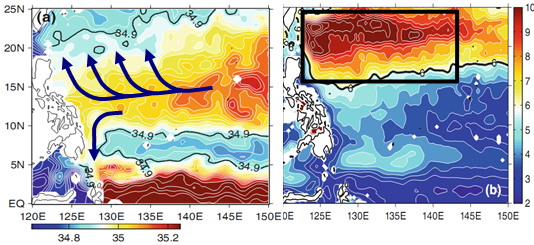The interim meeting of National Basic Research Program of China “Structure, Variations and Climate Impacts of Ocean Circulation and the Warm Pool (WP) in the Tropical Pacific Ocean” was held in Beijing August, 2013. The chief scientist of this project is Dr. Wang Fan. Shen Jianlei from Department of Basic Research, Zhang Hongxiang from Bureau of Frontier Sciences and Education Chinese Academay of Sciences, Ren Xiaobo from Bureau of Major R&D Program Chinese Academy of Sciences, program expert panel, domain expert advisory group and nonparticipating peer expert were invited to attend the meeting.
Shen Jianlei and Zhang Hongxiang made speeches respectively; chief scientist Wang Fan reported the progress of the program.
The important research development of this project are as follows: 1) finding the irregular annual variability of the North Equatorial Current (NEC) transport and the semiannual variations in the Philippine Sea, revealing the Western Pacific North Equatorial Counter Current annual variability and its response to different types of El-Nino events. 2) discovering and naming the Tropical Sub-Surface Water (TSSW) in the northwestern tropical Pacific Ocean, finding the internal pathway of the interannual variability of subsurface water between tropic and subtropic;3) By using ROMS-SWAN couple model and large eddy turbulence simulation, the effect of Langmuir circulation and wave breaking on the upper layer mixing is studied in detail; 3) The seasonal variability of WP T-S structure, and its relationship to ENSO is present quantitatively, the possible mechanism are also discussed; 4) the WP salinity budget and its relationship to ENSO barrier layer and salinity front are analyzed; 5) A new method to evaluate the turbulence property using CTD data is developed; 6) the WP heat content is analyzed, the result shows that heat content is good index on demonstrating the effect of WP on Chinese seasonal climate variability.

Figure 1 The movement of NPTW in subsurface is highly correlated to the west boundary current and equatorial current system. (left)Salinity maximum in subsurface;(right)High frequency variation of the observed SSH.
As far as the research on El Nino is concerned, two types of El Nino are studied in detail. The central type El Nino is simulated successfully; a case of successful forecasting of the 2011 “double dip” central type La Nina is analyzed in detail, finding that the beforehand reaction of Pacific meridional mode to two types of El Nino is quite different. On the model development, a nested high resolution ocean model and an immediate atmosphere-ocean coupled model are developed to study the WP region. The immediate atmosphere-ocean coupled model is innovative by considering the salinity and fresh flux. The CNOP method is also proved to be very suitable in the predictability study of El Nino.
By the end of June 2013, 67 papers, including 40 SCI papers have been published with the first or second supported by the project. Two monographs “ENSO and its relationship with the ocean environment and Chinese climate anomaly” (Chen Yongli, Zhao Yongping, Wang Fan, 2013, Sciences Press) and “The characteristic of the heat flux variability in Asia-Indi-Pacificregion and its climate effect” (Chen Jinnina, Wang Hongna, Zuo Tao, He Yijun, 2013, Ocean Press) have been published. Two dataset, “global XBT corrected dataset” and “Indo-pacific ocean heat flux dataset”, have been released and can be access for free. Under the support of this project 7 postdocs, 11 doctors and 17 masters have been trained or graduated. Dr. Wang Fan, the Chief scientist, has been awarded “National Excellent Scientific and Technological Worker” and “National Young and Mid-aged Science and Technology Innovation Leader”. Dr. Mu Mu and Dr. Wang Fan have been invited to give speeches at international conferences, and the research team also enhances communication with other experts in various forms.
In this meeting, directors of different themes reported their works and answered the questions of the expert panel. Experts such as Academician Huang Ronghui and Hu Dunxin, etc. discussed and appraised the current research and prospect of the program. Expert appreciated the research results and work status of the team, indicating that different themes has been integrating to each other very well and have achieved most research goals on plan. Meanwhile, expert advised that the results should be refined to present the innovative feature, and take these innovations as the key point of the future work.




